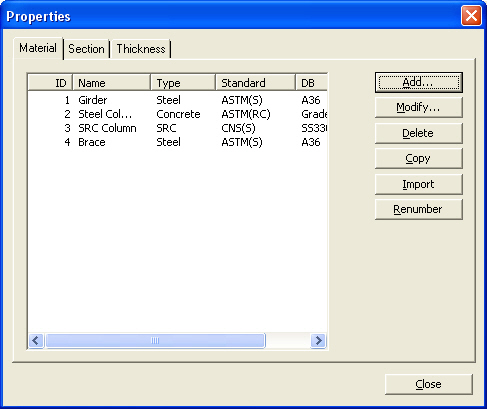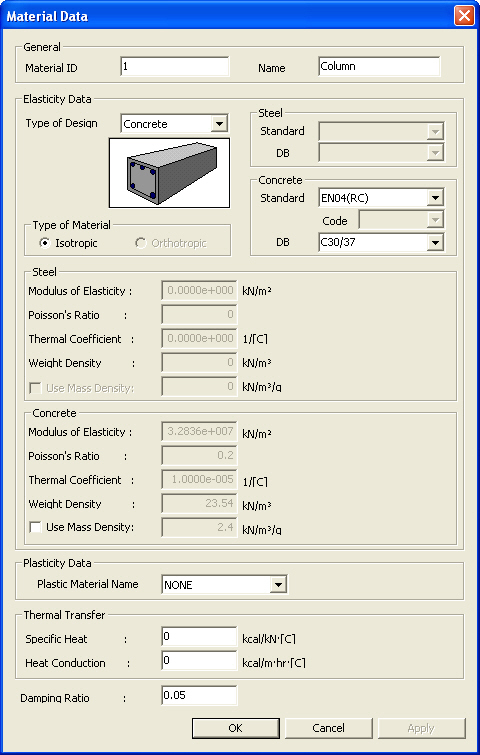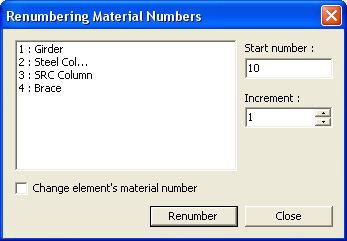Material
|
|
|
|
|
|
Enter the isotropic and orthotropic material properties. The user should enter the orthotropic material in User Defined Material. |
|
|
|
|
|
|
|
From the Main Menu select Model > Properties > Material.
Select Geometry > Properties > Material in the Menu tab of the Tree Menu.
Click |
|
|
|
|
|
Properties (Material) dialog box
Material Data dialog box
For new or additional material properties Click
General
Material ID: Material property number
Name: Material property name
Elasticity Data
Type of Design: Select a material property type and enter the related data.
Standard: Select the standards of a country in the field. None: The user defines the material properties directly. The user may modify the data obtained from the DB standards. ASTM(S): American Society for Testing Materials CSA(S): Canadian Standards Association BS(S): British Standard BS04(S): British Standards / BS EN 10025 (2004) DIN(S): Deutches Institut fur Normung e.v EN(S): European Standard JIS(S): Japanese Industrial Standards JIS-Civil(S): Japanese Civil Standards GB03(S): Chinese National Standard GB(S): Chinese National Standard JGJ(S): Chinese Industrial Standard JTJ(S): Chinese National Standard of Highway Engineering JTG04(S): Chinese Technical Standard of Highway Engineering. Wire and heat treated rebar materials can be selected from DB TB05(RC): TB 10002.3-2005 (Code for design on reinforced and prestressed concrete structure of railway bridge and culvert) Revision of V.7.6.1 KS08(S): Korean Industrial Standard (S.I. Units) KS(S): Korean Industrial Standard KS08-Civil(S): Korean Civil Standards (S.I. Units) KS-Civil(S): Korean Civil Standards IS(S): Indian Standards CNS(S): Chinese National Standard DB: Select a steel type recognized in each of the standard codes. Standard: Select the standards of a country in the field. None: The user defines the material properties directly. The user may modify the data obtained from the DB standards. ASTM(RC): American Society for Testing Materials CSA(RC): Canadian Standards Association BS(RC): British Standard Note EN(RC): European Code JIS(RC): Japanese Industrial Standards GB(RC): Chinese National Standard GB-Civil(RC): Chinese National Standard JTG04(RC): Chinese Technical Standard of Highway Engineering TB05(RC): TB 10002.3-2005 (Code for design on reinforced and prestressed concrete structure of railway bridge and culvert) Revision of V.7.6.1 KS01(RC): Korea Industrial Standards (in SI unit system) KS(RC): Korean Industrial Standards (in MKS unit system) KS-Civil(RC): Korean Civil Standards (in MKS unit system) KS01-Civil(RC): Korean Civil Standards (in SI unit system) IS(RC): Indian Standards CNS(RC): Chinese National Standard JTG04(S) : Jiao Tongbu Gong Lu Biao Zhun (China) UNI(RC): Italian National Standards Code: Select a corresponding concrete design standard for considering the change of modulus of elasticity. This option is active DB: Select a concrete type recognized in each of the standard codes. Enter the material properties for steel and concrete in the Steel and Concrete entry windows similar to the above Type = 'Steel', 'Concrete' cases. Type
of Design = 'User Defined' Select when the material type is not
'Steel', 'RC' or 'SRC', or when the user wishes to define the material
properties directly. Modulus of Elasticity Poisson's
Ratio Celsius Fahr Weight
Density Shear
Modulus: Shear Modulus of Elasticity(Local-xy, Local-xz, Local-yz) Note Use Mass Density: Mass per unit volume. Note Plasticity Data
Enter plastic material data.
Plastic Material Name: Select a Plastic Material whose plastic model properties have been defined in the Plastic Material dialog box.
Thermal Transfer
Thermal transfer data
Specific Heat
Heat Conduction
Revision of Gen 2011
Damping ratio
Define the damping ratio by materials.
Note 1
Apply different damping ratios to concrete and steel for response spectrum analysis / time history analysis. - Response Spectrum Analysis : When Strain Energy Damping is selected, the damping ratios can be defined by materials. - Time History Analysis : When Strain Energy Damping or Element Mass & Stiffness Proportional is selected, the damping ratios can be defined by materials.
Note 2
The default damping ratios for each material are: - Steel : 0.02 (2%) - Concrete / SRC : 0.05 (5%) - USER : 0.00 (0%)
To modify previously entered material property data Select the material property to be modified
in the list of the Properties dialog box and click
To remove previously entered material property data Select the material property to be deleted
in the list of the Properties dialog box and click
To copy previously entered material property data Select the material property to be copied
in the list of the Properties dialog box and click
To import material property data from an existing fn.MGB file Click
Material
List
Selected
List
Note
Numbering
Type
Keep ID.
New ID.
To modify previously entered material property numbers
Renumbering Material Number dialog box
Start number
Increment
Change
element's material number
|
|
|
 Material
Material

 in the Properties
dialog box and enter the following data:
in the Properties
dialog box and enter the following data: to modify
the related data.
to modify
the related data. .
. .
. and select the MGB file
containing the material property data or specify a file name then click
and select the MGB file
containing the material property data or specify a file name then click
 .
.